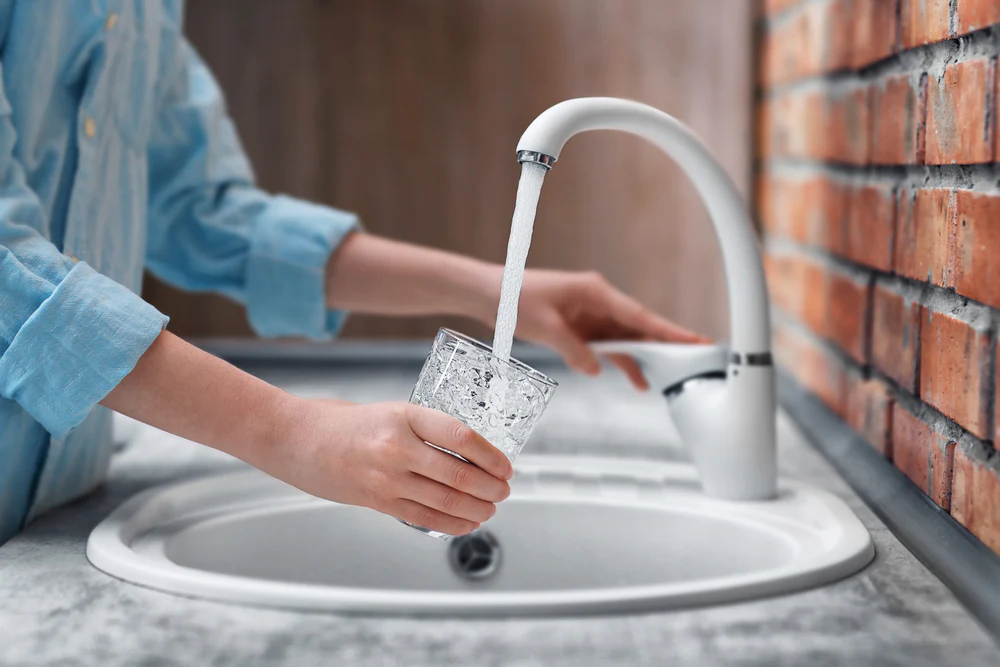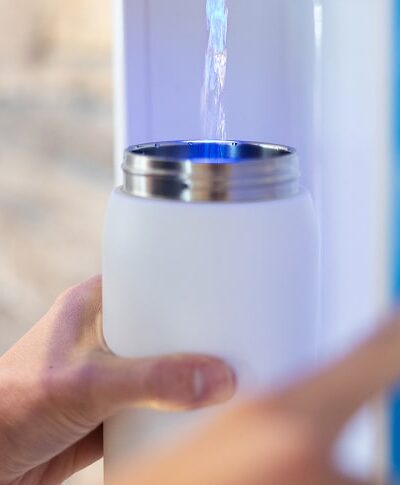Updated July 7 2024
There is an extensive list of foods and activities that should be avoided during pregnancy, but have you ever considered how safe drinking tap water while pregnant is? Although cities are supposed to follow the guidelines issued through the U.S. Environmental Protection Agency’s (EPA) Safe Drinking Water Act, there are certain areas where the water quality doesn’t meet these standards or contain more contaminants than others.
To ensure safe drinking water during pregnancy, it’s important to know what kind of chemicals could affect pregnancy and the health effects they may cause on the body. Certain contaminants may lead to birth defects and other health problems for women who are pregnant and their young children.
Being informed about your water supply and what safe alternatives are available can help provide peace of mind when it comes to whether or not you should rely on drinking tap water while pregnant.
Safety Around Drinking Tap Water
The Safe Drinking Water Act was passed in 1974 with amendments established in 1986 and 1996, in an effort to regulate and protect the country’s public drinking water supply by issuing guidelines all public water facilities must adhere by, in order to limit the amount of contaminants in drinking water. Among the most recent amendments include:
- All community water systems must prepare and share annual Consumer Confidence Reports with the public that includes information about where their water is being sourced from, the types and amounts of contaminants found in water, and the possible health effects they may cause.
- The EPA is responsible for strengthening control over contaminants as well as byproducts of chemical disinfection used as part of water treatments. Certain water treatments also contain materials that may prove harmful to health.
- Water system operators must be certified to ensure safe operation of all water systems.
In general, the act protects the public’s right to know where their water comes from and their risk of contamination. There are several factors that can affect the water quality, such as polluted water sources, deteriorating city or home pipes, water systems made primarily of lead, and other environmental factors that can affect how much of certain chemicals and contaminants enter the waterflow at any given time.
How Chemicals in Water Could Affect Pregnancy
There are multiple pollutants, including chemicals, bacteria, and viruses that enter a water source that can be damaging to the body, especially those most vulnerable. Lead, perfluorochemicals (PFOAs), Bisphenol-A (BPA), and pesticides are among the most common that can affect women drinking tap water while pregnant.
Lead
The Centers for Disease Control and Prevention (CDC) outlines several safety warnings for pregnant women who drink water contaminated with lead. It states too much lead exposure in the body can:
- Increase the risk for miscarriage
- Cause the baby to be born prematurely
- Harm a baby’s brain, kidneys, and nervous system
- Lead to learning or behavioral problems
Women who have lead exposure while pregnant, when breastfeeding, or use contaminated water to mix baby formula can inadvertently increase the likelihood of these events in babies in their first stages of development. Since lead is considered a cumulative toxin, even small amounts of lead in tap water over time can result in adverse health effects. Water contamination isn’t the only source; exposure occurs in other ways, such as through lead paint, lead fuel, and other everyday environmental hazards.
Perfluorochemicals (PFOAs)
PFOAs are man-made chemicals that’ve been used since the 1940s for nonstick and stain-resistant cookware and food packaging. They’ve been linked to reduced birth weight and birth defects. Per the CDC, there’s also been consistent finding of increased cholesterol levels, effects on the immune system, and increased risk of cancer.
Exposure can occur when using any of these everyday kitchen items, but many cases have been uncovered due to improper protections put in place from industrial factories responsible for manufacturing these products and shared a common water source with nearby residents.
Bisphenol-A (BPA)
In addition to the harm caused by BPOAs, the National Institute of Environmental Health Sciences also points out the risk factors of exposure to BPA. This chemical has been largely used in food and drink packaging, including single-use plastic water bottles and infant bottles.
BPA has been linked to birth defects, neurodevelopmental disorders, such as attention-deficit hyperactivity disorder and autism, obesity, and diabetes. While many bottle makers are changing the way they manufacture their products, another way to decrease exposure is to reduce mixing BPA products with heat from the microwave or dishwasher, which allows the chemicals to leach into the food or bottled water.
Pesticides
Pesticides found in food sources and at-home use for gardening can cause adverse health effects during pregnancy, including impaired cognitive and neurodevelopment reactions and activity, impaired fetal growth, childhood cancer, and increased risk of testicular cancer. Pesticides enter the water source from agricultural runoff and stormwater drains from both industrial and residential use.
These are the few main chemicals that pose danger to women who drink tap water while pregnant. However, there are several other pollutants that can affect the health of women who are pregnant and their babies. While exposure to these chemicals can be found from multiple sources, the effects of drinking contaminated water has been confirmed by several studies.
Studies Linking Tap Water with Birth Defects
There are numerous studies that support evidence that links the risks of drinking tap water while pregnant with birth defects. It depends on the water source, how chemicals interact with each other, and the amount of chemicals found in the water that will increase these dangers. Two of the main areas of exposure are chemical leaching from outdated water systems and chemical exposure from agricultural disposal runoff seeping into the water supply.
Chemicals Leaching from Old Pipes
Collaborative research from Boston University School of Public Health and the University of California, Irvine concluded exposure to high levels of PCE-contaminated drinking water during the first trimester of pregnancy increased the odds of having a child with spina bifida, cleft lip, or hypospadias. PCEs or perchlorethylene, also referred to as tetrachloroethylene, are generally used in cleaning agents. However, this particular study found the contaminated water to be the result of leaching from asbestos cement water pipes.
Old, deteriorating public water systems as well as older homes present a higher risk of chemicals leaching into the water and making their way to the tap. Many cities carry warnings regarding their water supplies due to outdated pipes, many of which aren’t quickly replaced due to cost and logistics of taking on such a time-consuming, complex process. Although modern pipe systems do not use vinyl-lined asbestos or lead as part of its manufacturing, those exposed to older systems may still be at risk.
Chemical Exposure Caused by Agricultural Runoff
Another study issued by the Texas A&M Health Sciences Center School of Public Health also provides evidence that shows links between drinking tap water while pregnant and birth defects. The research focused primarily on women who ingested water contaminated with large amounts of fertilizer chemicals during pregnancy.
Agricultural chemical runoff that leaches into the soil can end up in public water supplies, in addition to naturally occurring elements, such as arsenic, all of which can create health problems. The research points out the mixture of certain chemicals to create new compounds is what could be the catalyst of birth defects, including problems with the heart, neural tube, and abdominal area.
Women who live in rural areas may be at higher risk due to the proximity to these types of facilities, although it can affect big cities too depending on where they source their water supply.
Transforming Tap Water for a Safer Drinking Experience
There are many precautions women face when pregnant and erring on the side of safety can bring peace of mind. Every public water facility is required to provide a Consumer Confidence Report that lists where your tap water is sourced from, the type of chemicals that are found in the water, and the levels at the time of testing. This provides transparency into knowing what harmful contaminants are in your water, including the disinfectant properties used to treat the water at the source.
For an extra layer of protection, using an at-home purification system can eliminate and reduce the chemicals that may still linger or leach from pipes as the water makes its way to your tap. The FloFaucet uses a multi-stage carbon block filtration process to remove or reduce 80+ known contaminants, resulting in healthier, great-tasting, and clean water. It gives families the option of still using their main water supply but filtering out harmful chemicals, bacteria, viruses, and other pollutants that may still remain.
Plus, it eliminates the need for single-use plastic water bottles, which people commonly rely on as an alternative water source. Using FloFaucet during pregnancy and when mixing formula for babies can provide a safer water drinking experience. With a simple installation on compatible faucets, it’s easy to use by all for a constant supply of purified water without the use of plastic. Safety during pregnancy is paramount and being confident in your clean water supply is essential for the health of your family.
Sources:
https://www.cdc.gov/nceh/lead/prevention/pregnant.htm
https://www.who.int/news-room/fact-sheets/detail/lead-poisoning-and-health
https://www.psr.org/wp-content/uploads/2018/05/prenatal-exposure-to-chemicals.pdf
https://www.epa.gov/pfas/basic-information-pfas
https://www.niehs.nih.gov/health/topics/agents/sya-bpa/index.cfm
https://pubmed.ncbi.nlm.nih.gov/30400949/
https://vitalrecord.tamhsc.edu/agricultural-compounds-drinking-water-linked-birth-defects/




